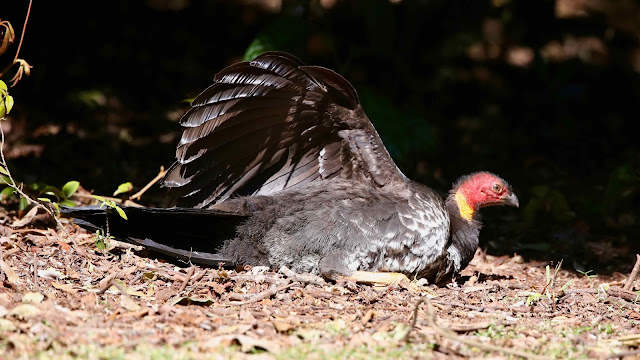On a recent
trip, we found large numbers of White-cheeked Honeyeaters (Phylidonyris niger) along the NSW north coast especially where Coast
Banksia (Banksia integrifolia) were in
flower.
The
Australian Bird Guide Menkhorst et al describes this species well, “Sedentary or local blossom nomad, highly
nectivorous; also catches insects by sallying. Gregarious, noisy, pugnacious
and conspicuous.”. This is also a good description for the closely related New
Holland Honeyeater (Phylidonyris novaehollandiae)
which is common in East Gippsland. The White-cheeked is not found in East
Gippsland though there have been a few reports of rare individual birds – for example
one was sighted on Raymond Island on the Gippsland Lakes in the last year or
so.
While the
White-cheeked Honeyeaters were very numerous and active, in fact I would say
hyper active - like kids on red cordial at a birthday party, I found them warier
than the New Holland and harder to pin down for photos. I did catch up with one
in the Arakwal National Park on the coast just south of Cape Byron. Most of the
White-cheeks were busy in the Coast Banksia flowers where nectar was clearly
the attraction. However the bird in the following photos was chasing insects –
I suspect this bird had young it was feeding in a nest as it was gathering
insects and not eating them as it went.
Please click on photos
to enlarge.
 |
| Note the insect protruding from the bill. |
Another
name for the White-cheek is Moustached Honeyeater which perhaps better
describes the white cheek patch which is not a patch but rather a fan-shaped
plume. The white feathers emerge as a tuft of feathers from the cheek and fan
out in a plume. This is obvious in the following photos.
Like the similar
New Holland, the White-cheeked Honeyeater has a bold and conspicuous yellow
panel on the folded wing – the yellow outer tail feathers are also conspicuous.
South of
Byron Bay at the small coastal township of Red Rock I found a very confiding
juvenile White-cheeked Honeyeater in salt and wind stunted Coastal Banksia on
the headland. The trusting young bird emerged from the dense banksia every time
I walked by its location on the climb to the headland.
 |
| Juvenile White-cheeked Honeyeater – note the yellow gape and the rather dishevelled appearance. |
Even though
the New Holland Honeyeater’s range overlaps with the White-cheeked along the
northern NSW coast, over a three-week period during July and early August from
Byron Bay to Gosford, we did not see one New Holland which was a little surprising
given the habitat looked perfect for them.

























